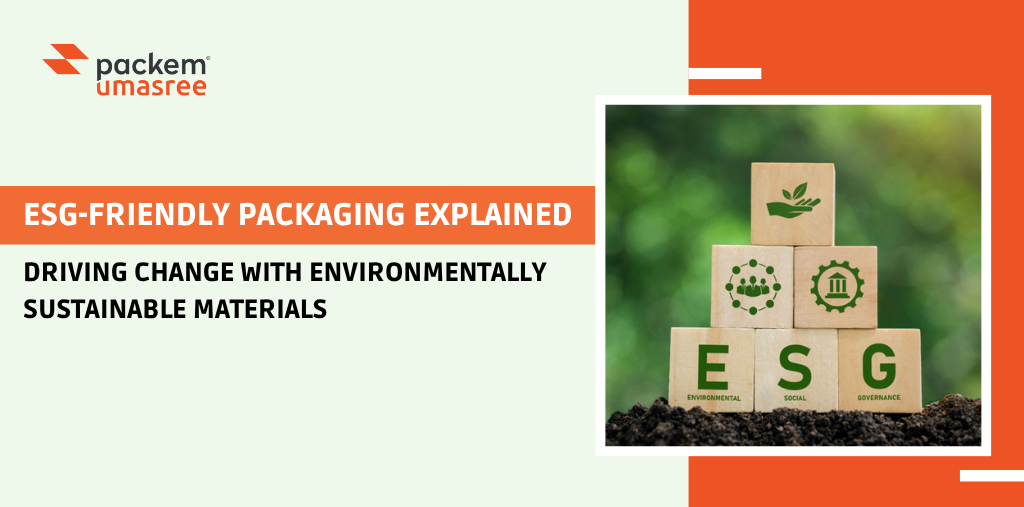Packaging is no longer just about wrapping or transporting products—it is about responsibility, accountability, and sustainability. In a world where climate change, waste generation, and consumer awareness are at the forefront, businesses are expected to move toward ESG-friendly packaging solutions. These solutions align with Environmental, Social, and Governance (ESG) principles, making packaging not only functional but also ethical and future-ready.
This blog explains what
ESG-friendly packaging means, its significance, the materials used, and how industries worldwide are benefiting from its adoption.
What Makes Packaging ESG-Friendly?
To be considered ESG Compliant Packaging, a solution must do more than protect a product. It must minimize environmental damage, uphold social responsibility, and meet governance standards.
- Environmental Aspect: Uses recyclable, compostable, or reusable materials that reduce waste and carbon footprint.
- Social Aspect: Protects consumer safety, ensures fair labor in production, and supports communities.
- Governance Aspect: Meets packaging regulations, provides transparency in sourcing, and promotes ethical business practices.
In essence, ESG-friendly packaging tells customers and stakeholders that a company is serious about sustainability, compliance, and long-term impact.
Why is ESG-Friendly Packaging Transforming the Industry?
Businesses worldwide are shifting toward ESG-friendly practices, and packaging is a crucial part of this movement. Here’s why:
➔ Consumer Behavior is Changing
Modern customers prefer eco-conscious brands. Packaging that carries an “eco-friendly” or ESG-compliant label often becomes a key decision-maker at checkout.
➔ Global Laws are Getting Stricter
Governments are implementing bans on single-use plastics, recycling targets, and waste reduction policies. Companies adopting ESG-friendly packaging avoid legal risks and stay competitive.
➔ Investor and Partner Confidence
ESG scores are now used by investors to evaluate companies. Brands using ESG-compliant packaging signal resilience, responsibility, and innovation.
Types of Materials Used in ESG-Friendly Packaging
A significant part of ESG compliance comes from the choice of packaging materials. Companies are experimenting with both traditional and innovative solutions.
- Recyclable Packaging: Paper, cardboard, rPET, and aluminum are leading materials that can be reused multiple times in circular systems.
- Biodegradable Options: Plant-based polymers and natural fibers that decompose naturally, reducing landfill pressure.
- Compostable Packaging: Breaks down into non-toxic organic matter under the right conditions, commonly used in food packaging.
- Reusable Systems: Glass jars, cloth bags, and refill models help reduce the single-use packaging culture.
- Lightweight Packaging: Thinner, optimized designs that save raw materials and cut transportation emissions.
ESG-Friendly Packaging Across Key Industries
- Food & Beverages: Restaurants and food brands are adopting compostable trays, biodegradable films, and recyclable cartons. This ensures product freshness while reducing environmental footprint.
- Retail & E-Commerce: E-commerce giants are replacing plastic fillers with paper-based alternatives. Recyclable boxes and biodegradable mailers improve customer trust and align with ESG goals.
- Agriculture: FIBC bags with eco-friendly liners and biodegradable sacks are now widely used for crops, minimizing contamination risks while ensuring sustainability.
- Chemicals & Industrial Goods: Industries are switching to ESG-compliant packaging such as rPET-based liners and bulk containers that combine safety with sustainability.
ESG Friendly Packaging and the Circular Economy Connection
The idea of the circular economy—reuse, recycle, and regenerate—is central to
ESG-friendly packaging. Instead of packaging being a single-use item, the goal is to create a cycle where materials remain in use for as long as possible.
Benefits include:
- Lower dependency on virgin raw materials.
- Less landfill accumulation.
- Reduced emissions in manufacturing and logistics.
- Long-term cost efficiency for businesses.
Challenges Businesses Face in Adopting ESG-Friendly Packaging
While the transition is vital, it comes with challenges:
- Cost Factors: Sustainable materials often cost more initially than conventional plastic.
- Supply Chain Gaps: Limited availability of advanced biodegradable or compostable materials in some regions.
- Consumer Education: Many consumers are still unaware of how to properly recycle or dispose of ESG-compliant packaging.
- Technical Limitations: Some eco-materials may not provide the same shelf-life or durability as traditional plastics.
Businesses overcoming these barriers gain long-term competitive advantage and brand loyalty.
How Businesses Can Transition Toward ESG-Compliant Packaging?
Adopting
ESG-friendly packaging is a structured process, not an overnight change. Here’s a roadmap:
- Audit Your Current Packaging – Understand the environmental and social impact of your packaging materials.
- Switch to Greener Materials – Start with recyclable or lightweight options and gradually move toward biodegradable or compostable solutions.
- Work with ESG-Compliant Suppliers – Collaborate with packaging partners who specialize in eco-friendly liners, sacks, and bulk bags.
- Train and Educate Teams – Ensure that your staff and consumers understand how to use, recycle, or return packaging effectively.
- Leverage Technology – Use tools like carbon footprint calculators and life cycle analysis (LCA) to measure progress and adjust strategies.
The Future of ESG-Friendly Packaging
The global packaging industry is heading toward smarter, greener, and more innovative solutions. Future trends include:
- Biodegradable Innovations: Development of stronger, faster-degrading plant-based plastics.
- Reusable Packaging Models: Brands offering refill stations or container return programs.
- Smart Packaging: Integration of QR codes or tracking technology for recycling instructions.
- Automation & AI in Logistics: Optimizing supply chains to reduce energy consumption and packaging waste.
Companies adopting ESG-compliant packaging now are positioning themselves as leaders in sustainability, gaining early trust from consumers, investors, and regulators.
Conclusion
ESG Friendly Packaging is more than a sustainability buzzword—it is a necessity in the modern business world. By reducing environmental impact, ensuring social responsibility, and meeting governance standards, it empowers companies to build a brand that is responsible, ethical, and future-proof.
Whether through recyclable cartons, compostable films, or reusable solutions, businesses have the opportunity to lead meaningful change and support a greener economy. The shift to ESG Compliant Packaging is not just about compliance—it’s about securing long-term success.
At
Packem Umasree, we specialize in designing sustainable, innovative, and ESG-compliant packaging solutions tailored to your industry. From eco-friendly FIBC bags to packaging liners, our solutions help businesses achieve their sustainability goals while ensuring safety and efficiency.
Contact Packem Umasree today to discuss how we can support your packaging transformation.
